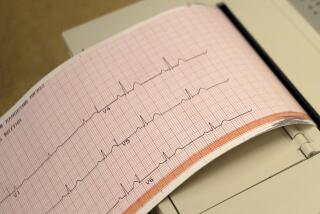Doctors Tap System for Medical Data : Computers Help With Diagnoses
A San Jose hospital will soon join an exclusive club of U.S. medical facilities that use a controversial new computer system that helps physicians treat patients more efficiently by quickly searching its vast data base of medical knowledge to give doctors a second opinion.
Physicians and medical personnel at O’Connor Hospital in San Jose began taking classes in January to prepare this summer to use the $2-million HELP Medical Information and Logic System computer, which was first marketed in 1983 and has, along with other computers of its type, sparked widespread debate in medical and legal circles about whether it dehumanizes medical practice and encourages doctors to use it as a diagnostic crutch.
“Our docs are looking forward to using it,” said Bert Baumer, vice president of finance at O’Connor. “Most of them see that it has the potential to help them and don’t view it as threatening,” he said, adding that installation of the system will begin in July and be completed by next March.
$600-Million-a-Year Business
More and more medical facilities are rolling out the welcome mat to computers these days as physicians battle a growing mountain of health-insurance paper work, as well as contend with new drugs and diseases. Computers that process insurance and bookkeeping data, for example, already make up a $600-million-a-year business at the nation’s 5,800 hospitals, estimates Arthur D. Little Inc., a Cambridge, Mass.-based consulting firm.
The 17-month-old HELP system, manufactured by Minneapolis-based Control Data Corp., combines those hospital record-keeping functions with a data base of medical knowledge containing information about thousands of diseases, symptoms and treatments.
Although more powerful medical computers exist, the HELP system is the most sophisticated “of the commercially available packages,” said Dr. Donald W. Simborg, who was director of hospital information systems at the University of California Hospitals in San Francisco and is now president of Simborg Systems Corp., a Corte Madera, Calif., computer consulting firm.
“The system watches all the information going into the patient’s record and looks for anomalies,” said Phillip G. Martin, vice president of health-care services at Control Data. “A message will come right back to the doctor (saying), ‘Oh, by the way, these drugs are not compatible.’ ”
Baumer said O’Connor became interested in the HELP computer primarily because of its flexibility and its vast information-processing capability. He said, for instance, that the system enables a doctor to keep track of his patients’ progress from his office or home and can store patient data much longer than 72 hours, the current computer’s limit.
The data base for the system, which can be tailored to a hospital’s specific needs, was developed at LDS Hospital and the University of Utah School of Medicine in Salt Lake City.
Besides those facilities, the computer is now being used at Arnot-Ogden Memorial Hospital in Elmira, N.Y., and is being installed in Rex Hospital in Raleigh, N.C.
In addition to creating an electronic file and even issuing an identification wrist band when a patient is admitted, the computer is programmed to react to the changing condition of patients as a disease progresses or as new laboratory tests or information becomes available.
Suggest Tests
The computer collects information about the patient from a medical record fed into the system by nurses or doctors. This record includes the patient’s history and physical examination, doctors’ and nurses’ notes and data about the patient from monitoring equipment--such as an electrocardiogram--and from laboratory test machines--such as an automatic blood analyzer.
And it doesn’t wait for the doctor to ask a question. It instantly analyzes information, suggesting tests and alerting doctors to harmful drug combinations or patient allergies.
“Our physicians follow the advice of the computer about 80% of the time,” said Homer R. Warner, who helped develop the computer and is chairman of LDS’ medical biophysics deparment. “The other 20% of the time the computer isn’t accurate.” Sometimes, Warner said, a doctor must prescribe a drug even though the computer has sounded an alert because it is the only drug available.
HELP has aided doctors in treating more than 400,000 patients, including Dr. Barney Clark, the recipient of the first artificial heart. Data on the condition of Clark--who died March 23, 1983, 112 days after his heart transplant--was transferred over phone lines from LDS Hospital to the University of Utah.
Martin estimates that there are 2,000 U.S. hospitals large enough to benefit from the equipment’s cost-saving capabilities and an additional 10,000 facilities overseas with 200 or more hospital beds.
“Our doctors are extremely pleased with the system; they call it their safety net,” said William J. Ritter, vice president and treasurer of Arnot-Ogden Memorial Hospital in Elmira.
Staff, Supply Costs Cut
He said the system has reduced the average patient stay at Arnot-Ogden by half a day and has saved the hospital about $1.8 million since it was installed in October, 1983. The savings have come mostly from staff reductions and supply costs achieved by using the computer, while the computerized diagnostic information has enabled doctors to determine more quickly whether a patient can be discharged early.
Yet, even as the computer has won praise from among its growing number of users, some are raising questions about its utility and its potential for harm.
“It can lead to dehumanizing medicine,” said Miles J. Zaremski, chairman of the American Bar Assn.’s committee on law and medicine and a partner in charge of health-care litigation at Lurie, Sklar & Simon in Chicago.
Zaremski said even sophisticated medical computer systems have the potential for making errors because “there are so many exceptions to the rule. How do you program in those exceptions?” he asked rhetorically. “Computers will make it more difficult to turn up areas of malpractice. Not only do you have to question the physician, you have to determine who was at fault with the computer--the software or the hardware manufacturer.”
And Lawrence Brenkus, a physician who has worked with the health technology unit at Arthur D. Little, said that, while “knowledge-based (hospital computer) systems are the wave of the future . . . medicine is complicated (and) even the very best of (today’s) programs can’t perform as well as a physician.”
More to Read
Inside the business of entertainment
The Wide Shot brings you news, analysis and insights on everything from streaming wars to production — and what it all means for the future.
You may occasionally receive promotional content from the Los Angeles Times.










